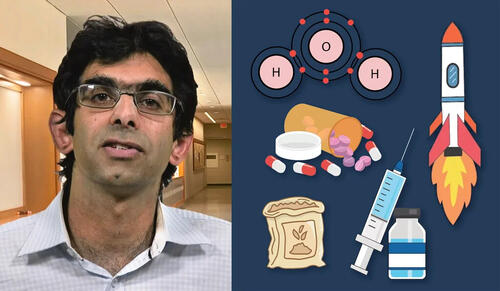
A video series created by Yale chemist Nilay Hazari — with help from undergraduates and Poorvu Center staff — makes foundational chemistry concepts accessible and engaging. Funded by the Poorvu Center’s Rosencranz Award for Pedagogical Advancement.
‘Nilay’s Chemistry Videos’ blends video, science — and educational equity
Full story by Jim Shelton appeared in YaleNews on December 19, 2023
For visual learners, a molecule of ethanol is easier to understand when its carbon, hydrogen, and oxygen atoms have careened onto a screen and spun around for a bit.
Likewise, for these learners the concept of heterogeneous mixtures can be more memorable when accompanied by images of chocolate chip cookies, carrot cake, and Chex mix.
Add in a charming host and a catchy title song, and you’ve got “Nilay’s Chemistry Videos” — a series of short YouTube videos about basic chemistry created by Nilay Hazari, the John Randolph Huffman Professor of Chemistry in Yale’s Faculty of Arts and Sciences.
“There’s been a big change in the educational paradigm for this generation,” Hazari said, evincing the same amiable spirit in person that he brings to his videos. “They’re visual learners who routinely seek out video resources when they take in new information.”
Working with the Yale Poorvu Center for Teaching and Learning and a trio of students, Hazari has completed nine videos and plans to cover all 11 chapters of the textbook he uses to teach “General Chemistry,” an introductory lecture class. So far, he’s at the end of chapter one.
“I like teaching this course and I enjoy doing the videos,” Hazari said. “I’m exposing people to the basic concepts of the subject I love.”
“Nilay’s Chemistry Videos” grew out of Hazari’s experiences with online teaching during the COVID-19 pandemic. As he adapted his lectures, class projects, and student interactions to a new educational landscape suddenly dominated by Zoom, he began to think more broadly about novel ways to serve his academic mission for a new generation.
In his “General Chemistry” class, for instance — which typically includes many non-science majors — there were increasing numbers of students who hadn’t been taught fundamental concepts such as states of matter or the scientific method.
“I felt there were key ideas I could cover in short videos, presented in a different way than I do in class,” Hazari said. “A student could watch the videos before or after class and have enough time to digest that information.”
Hazari took his notion of producing a video series to the Poorvu Center, which was fresh from a multi-semester effort to help faculty members translate their teaching expertise into innovative online presentations during the pandemic. Educational equity and creating opportunities to help students take ownership of their education are central to Poorvu’s mission — making Hazari’s suggestion a natural fit.
Poorvu helped Hazari obtain a $10,000 Rosencranz Award for Pedagogical Advancement to get started and set him up with students who would help with episode scripts, storyboards, animation, and video editing. The actual filming is done in front of a green screen at the Yale Broadcast Center.
“Lots of people are putting science videos out there, but what Yale brings to it is a well-recognized reputation for excellence,” said Jennifer Frederick, associate provost for academic initiatives and the founding executive director of the Poorvu Center.
“Nilay is able to break things down in a really clear and engaging way,” Frederick said. “I know how committed he is to students. He really knocked this project out of the park.” A trained chemist herself, Frederick likes the videos so much she sent a link for them to one of her kids, who is studying chemistry in high school.
Hazari’s approach to the videos is a winning mixture of clear language, playful graphics, and the occasional dad joke, such as this advice on how to think about “leading zeroes” in a scientific measurement: “Don’t let leading zeroes lead you on. They are not significant figures.”
He credits the videos’ quality to his student collaborators, including video editor Debbie Olorunisola, a Yale College junior who is majoring in statistics and data science.
In addition to editing the videos and suggesting animations and visual gags, Olorunisola said she tries to approach the finished product in the same way a non-chemist would view it — with an eye toward its helpfulness, brevity, and inventiveness.
“If I don’t understand something, then I’ll suggest a new visual,” she said. “Or I’ll say something if it seems like we have too many visuals. I love being part of this. A good video can be super helpful as a supplement to what you’re learning in class.”
And there is no reason why students around the world shouldn’t benefit as well, Hazari and Frederick said. Their hope is that the videos eventually reach a wide audience of learners beyond the Yale student population.
Those new viewers are in for a wild ride filled with thermodynamics, chemical bonding, and a highly catchy vocal rendition of the series’ name, “Nilay’s Chemistry Videos,” at the beginning and end of each episode.
“People definitely like the theme song,” Hazari said. “That was 100% the idea of the undergraduates who work with me on the videos. One of them has a suitemate who is in an a capella group and agreed to do it.”
